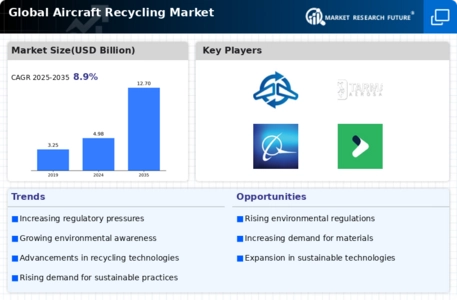Market Share
Aircraft Recycling Market Share Analysis
The Aircraft Recycling market is an increasingly important segment within the aviation industry, driven by the need for sustainable disposal and resource recovery from retired aircraft. In this evolving market, companies employ various strategies to position themselves effectively and capture market share. One key strategy is technological innovation. With the growing emphasis on environmental sustainability and regulatory requirements for aircraft end-of-life management, companies invest in advanced recycling technologies and processes. These innovations enable more efficient dismantling, component recovery, and material recycling from retired aircraft, minimizing waste and maximizing resource utilization. By offering cutting-edge solutions that meet environmental standards and customer demands, companies can differentiate themselves and gain a competitive advantage in the market.
Branding and reputation management are also crucial aspects of market share positioning in the Aircraft Recycling market. Establishing a strong brand identity and reputation for reliability, compliance, and environmental stewardship is essential for attracting customers and securing contracts. Companies that adhere to strict safety and environmental standards, such as ISO 14001 and OHSAS 18001, demonstrate their commitment to responsible recycling practices. Positive customer testimonials, certifications, and industry endorsements further enhance the company's brand image and competitive position in the market.
Price positioning is another critical consideration for companies in the Aircraft Recycling market. While aircraft recycling involves significant costs associated with dismantling, handling hazardous materials, and complying with regulations, companies must offer competitive pricing to attract customers and gain market share. By optimizing operational efficiency, streamlining processes, and leveraging economies of scale, companies can reduce costs and offer cost-effective recycling solutions to aircraft owners and operators. Moreover, flexible pricing models, including volume discounts and bundled service packages, cater to different customer segments and enhance market penetration.
Distribution and channel management play a significant role in market share positioning in the Aircraft Recycling market. Companies leverage various distribution channels, including direct sales, partnerships with airlines and aircraft leasing companies, and government contracts, to reach customers effectively. Establishing strategic alliances with maintenance, repair, and overhaul (MRO) facilities, as well as aviation regulatory authorities, ensures a steady supply of retired aircraft for recycling. Moreover, investing in customer relationship management systems, online platforms, and marketing initiatives enhances visibility, streamlines communication, and strengthens customer engagement, thereby reinforcing market position and loyalty.
Strategic partnerships and collaborations are instrumental in gaining market share in the Aircraft Recycling market. Companies often collaborate with aerospace manufacturers, MRO providers, and material suppliers to develop integrated recycling solutions and value-added services. Joint ventures and consortiums enable companies to pool resources, share risks, and pursue large-scale recycling projects more efficiently. Moreover, partnerships with government agencies, research institutions, and environmental organizations facilitate access to funding, regulatory support, and expertise, further enhancing market competitiveness and growth potential.







Leave a Comment